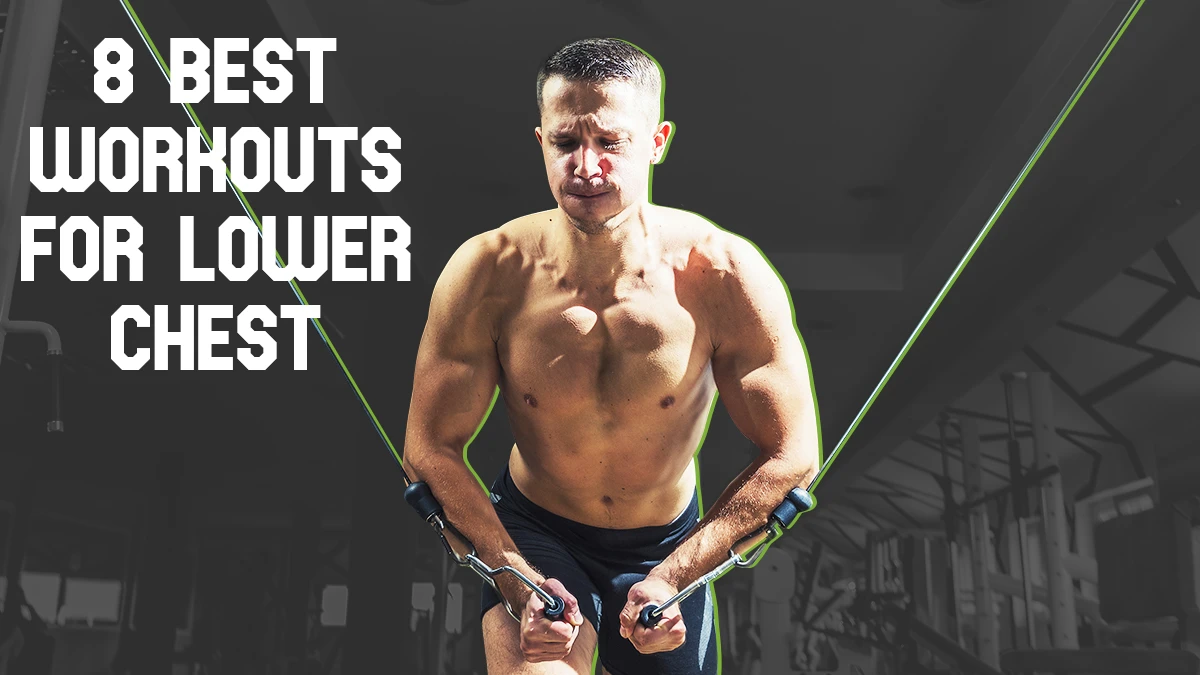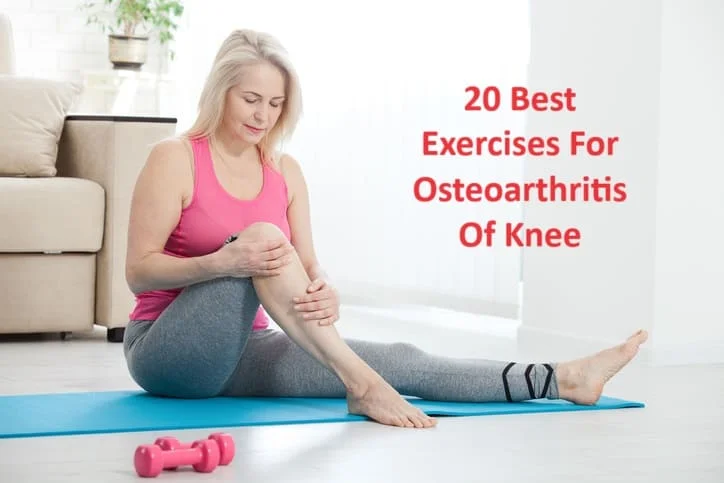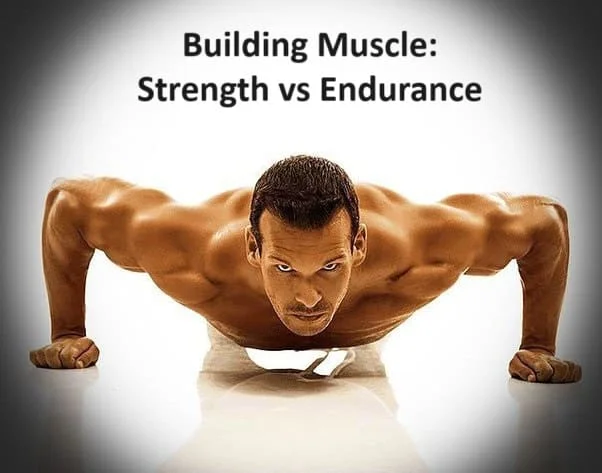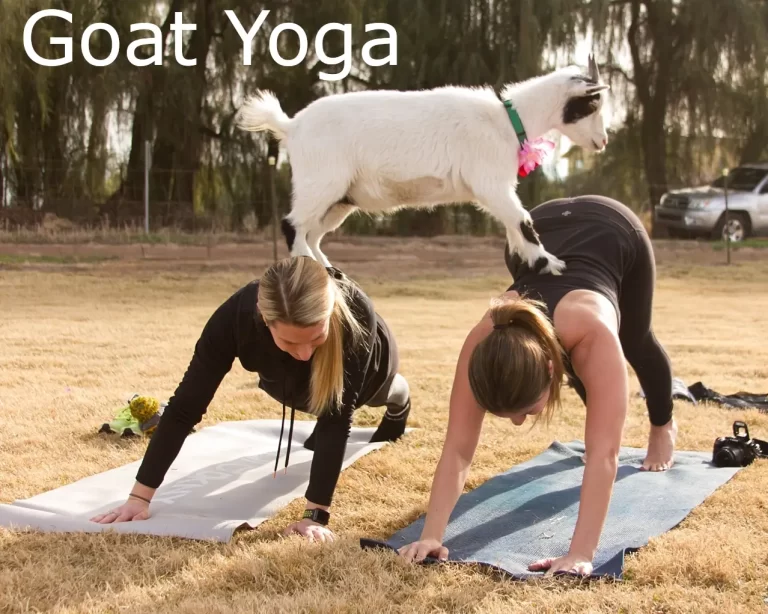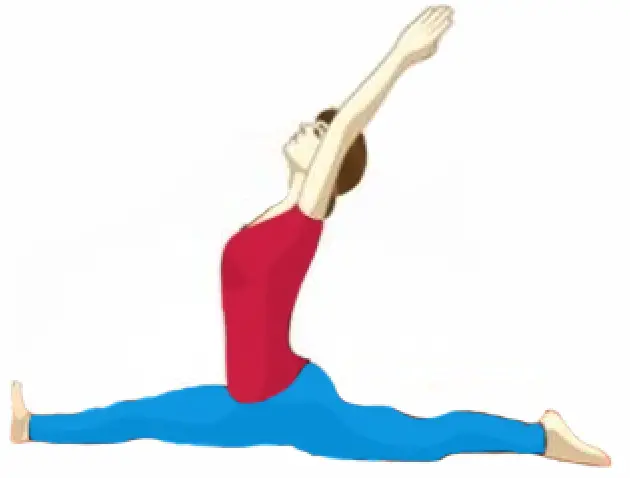8 Best Workouts For Lower Chest
Building a well-defined and balanced chest involves targeting different regions, and one area that often requires specific attention is the lower chest. Achieving a sculpted lower chest not only enhances overall aesthetics but also contributes to strength and functional fitness.
Table of Contents
Introduction
The Pectoralis major and Pectoralis minor are the two muscles that make up the pectoral muscles, or pecs. The majority of the lower chest muscles comprise the major. The minor is situated below the major and is much smaller.
A strong lower chest requires more than just popping your pecs, but that’s still rather impressive. You have to use your lower chest to twist and extend your arms. Discover in-depth the top 8 lower chest workouts that will help you develop stronger, more defined pecs.
Do you want a big and strong chest?
- The muscle groups in your upper, middle, and lower chests then need to be developed.
- I’ll outline ten of the top lower chest exercises in this post, along with suggestions for combining them into a program.
- Let’s start by examining your chest muscles to understand your training options better.
How to Work Your Lower Chest Muscles
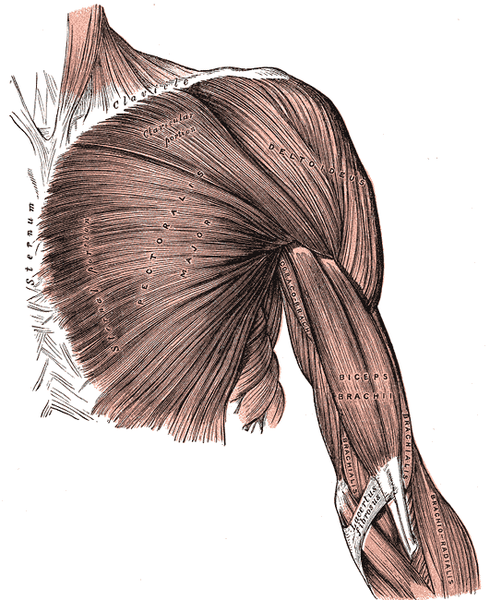
- The pectoralis major, or pecs, is the single, big muscle on each side that makes up almost all of your chest muscles.
- The major pectoralis is a big, fan-like muscle with wide roots.
- Usually, it is split into two sections:
- The larger, lower piece is called the sternocostal component, and it comes primarily from your sternum (but it also partially originates from your ribs and upper abdominal sheath).
- The smaller, upper piece that starts at the first half of your clavicle is known as the clavicular part.
- Fibers of muscle across this full range are incorporated into a single tendon that enters the front of the upper arm.
- The level at which you move your arm forward determines the quantity that each pectoral muscle fiber contracts.
- The clavicular head, or upper pec muscle fibers, will be the focus of incline pressing.
- The sternal head, or lower pec muscle fibers, are the focus of decline pressing.
- Similar to bench pressing, flat pressing targets the sternal and clavicular parts of the pec muscle very evenly.
- To target your lower pec, you should either perform exercises where you move your arm forward straight, which will work your chest muscles fairly evenly, or you can move your arm forward at a slight angle, which will highlight the lower chest fibers.
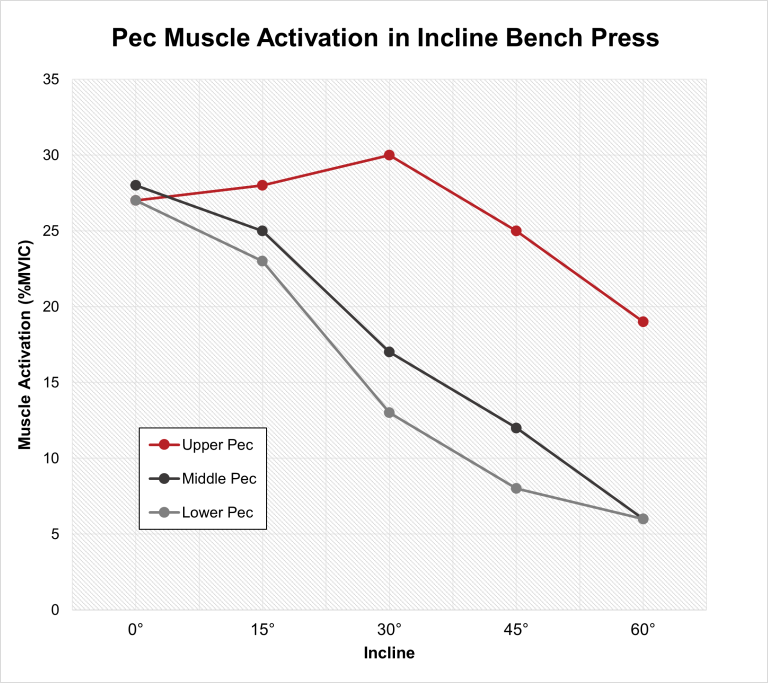
How You Can Train Your Lower Chest
- The best thing you can do is concentrate on strengthening your chest muscles as a whole.
- If you’re a serious bodybuilder, you’ll be better off working to build up your entire muscle group.
- However, you can adjust the angles on some of these exercises to give your muscles a different stimulus to better activate the lower chest some studies do suggest this method might be effective.
- Keeping that in mind, you can incorporate these exercises into your training to focus on the chest and increase its size and strength.
How To Workout Lower Chest
To be honest, who doesn’t enjoy large, round, buffy pecs?
- A well-defined chest is the foundation of a well-earned physique, capable of superimposing you on the world or helping you with your posture.
- Actually, it provides you with the stamina to go about your everyday business.
- Strong pecs come to the rescue for any task involving lifting, pressing, squeezing, tugging, or gripping! Additionally, having a muscular, well-built chest gives you a confident, solid stance.
Understanding the Anatomy of Your Chest
- Recognize the structure of your chest before you lift that weight or consume that pre-workout shake.
- Your chest muscle engagement will increase as a result of strengthening your mind-muscle connection.
- The pectoralis major, or pecs, is the main muscular group that makes up your chest.
- A pecs serve as a dumbbell rack in the gym.
- Similar to the upper rack, the clavicular head is attached to your collarbone.
- Similar to the lower rack, the sternal head is the thicker area of the chest.
- And that means it’s much more crucial to develop your lower chest.
Selecting the Appropriate Exercise Apparel for Your Chest Days
Your workout will not go as well as you would like if you are not comfortable during it.
For this reason, when striking the chest, it’s crucial to wear appropriate gym attire.
Ensure that your exercise attire is:
- Comfortable
- Supportive
- Breathable
- Easy to move in
Some options for chest days include:
- Tanks
- Stringers
- Performance or compression tees
- Oversized tees
Now that you have your training attire sorted, it’s time to start toning your pecs.
Here is a comprehensive guide sheet with our best selections for chest day in case you’re ready to be the talk of the town.
8 Best Workouts For Lower Chest
Let’s take a look at 8 fantastic lower chest exercises and how to put up a lower chest workout.
Chest Dips
Targeted Muscles: lats, front delts, triceps, traps, upper back, and major and minor pecs.
Sets: 3.
Reps: 6 to 10 reps as a warmup, 15 to 30 reps as a finisher.
Rest: 2-2.5 minutes.
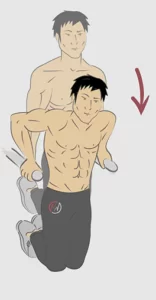
Steps To Follow
- Use dip bars or parallel bars.
- With the handles shoulder-width apart, grasp them.
- Raise your shoulders and arms and raise your torso a little.
- For stability, cross your feet and flex your shoulder blades.
- Forward torso flexion is necessary for chest engagement.
- Until your arms are fully stretched, push up.
- Lower your torso while maintaining your elbows close to your body.
- Maintain a neutral spine to prevent upper back hunching.
- To prevent momentum, keep things under control.
- Aim for a complete pec stretch or an elbow angle of 90°.
- Push your hands into the handles and pull back your shoulders.
- Perform 6–10 sets with more weight.
- Finisher: 15-30 bodyweight reps or to failure.
Seated Machine Fly
Targeted Muscles: lower pecs, front delts, and triceps.
Sets: 3
Reps: 10 to 12 reps.
Rest: 45-60 seconds.
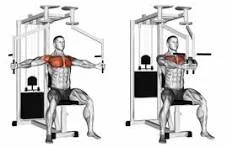
Steps To Follow
- To align the shoulder pads and arms, adjust the machine’s height.
- If you’re just starting out, start with less weight.
- Keep your elbows at a 57° angle to engage your chest.
- Hold each handle separately, keeping your grip loose.
- Place your head on the headrest, your chest forward, and your hips and shoulder blades firmly planted.
- Keep your stance stable and reel handles to your chest.
- As if you were going to punch each other, squeeze your pecs together.
- Imagine putting your arms around a tree trunk.
- Be careful about extending your arms too much to prevent injury.
- Steady your shoulders to avoid throwing.
- Re-extend your arms, tighten your grips, and maintain an engaged chest.
- Do 10–12 repetitions for each set.
Cable Crossovers
Targeted Muscles: lower pecs, front delts, triceps, and core.
Sets: 3
Reps: 10 to 12 reps.
Rest: 45-60 seconds

- Use weights that you are comfortable using and set the cable high.
- While experts can lift more weight, beginners start out light.
- Pull down the cables while standing in the center.
- Step forward a little to create a staggered stance.
- Parallel to the lower pec line, align the cable with the arms.
- For range of motion, keep arms less than 90 degrees from the body.
- While releasing arms, compress the upper back for stability.
- When extending your arms, slightly bend your elbows.
- Push your arms forward and down.
- Refrain from pressing too hard or flailing your arms.
- Squeeze your chest while making a butterfly wing motion.
- Consider putting a pencil in between your pecs.
- Do 10–12 repetitions in a set.
Decline Dumbbell Press
Targeted Muscles: lower pecs, middle pecs, front delts, and triceps.
Sets: 3
Reps: 10 to 12 reps.
Rest: 45-60 seconds.
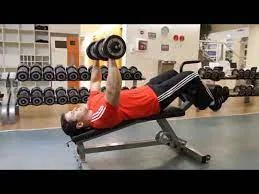
- Place your feet beneath the hook and tilt the bench to a 15° angle.
- With dumbbells resting on your thighs, arch your back.
- Bend your shoulders into the bench.
- Extend your arms fully when lifting weights.
- Dumbbells should be held parallel to your shoulder and perpendicular.
- To target the lower chest, lower the weights in a modest curve.
- Do not descend below the plane of the shoulders.
- For optimal pec tension, tuck in your elbows.
- Stretch your arms outward without going too far back.
- Do 10–12 repetitions in a set.
Dumbbell Pull-Overs
Targeted Muscles: lower pecs, mid pecs, lats, front delts, and triceps.
Sets: 3
Reps: 10 to 12 reps.
Rest: 45-60 seconds.
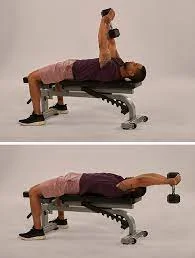
- To activate your chest, extend and maintain the tightness of your elbows.
- Select a bench that is level.
- With your back slightly arched, lie down.
- For stability, press your shoulder blades onto the bench.
- Tighten your thumbs underneath the dumbbells.
- As the weight presses you downward, extend your arms.
- Press with your outside hand to push the weight back up and prevent elbow bend.
- Puff up your chest while you raise your arms vertically above your upper abdomen.
- As you perform the movement, squeeze your pecs.
- Repeat for 10-12 repetitions per set.
Decline Bench Press
Targeted Muscles: lower pecs, middle pecs, back delts, and triceps.
Sets: 3
Reps: 10 to 12 reps.
Rest: 45-60 seconds.
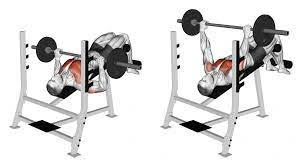
- Set the bench’s angle to 15 degrees.
- To keep your feet grounded, place them beneath the hook.
- Put your hips on a bench and slightly arch your back.
- With your hands shoulder-width apart, grab the barbell.
- Raise and drop the barbell to your lower chest.
- While bringing the bar down, slightly bend it.
- Squeeze your pecs while pushing back.
- Repeat ten to twelve times.
Seated Chest Press
Targeted Muscles: lower pecs, middle pecs, back delts, and triceps.
Sets: 3
Reps: 10 to 12 reps.
Rest: 45-60 seconds.
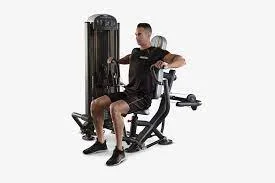
- Ascend to your chest in the seat height.
- To target the lower pecs, raise the machine.
- Sit with your feet positioned at a 90-degree angle.
- To keep your spine neutral, press your head on the headrest.
- For a back arch, roll your shoulder blades into the seat.
- Straighten your wrists to prevent harm.
- Maintain an elbow tucked in position of between 30 and 35 degrees.
- Hold the bar outward and press it against your chest.
- To activate your muscles, squeeze your pecs.
- Take a two-second rest after lowering the bar to allow your chest to expand before pushing again.
- Repeat ten to twelve times.
Decline Dumbbell Fly
Targeted Muscles: lower pecs, front delts, and triceps.
Sets: 3
Reps: 10 to 12 reps.
Rest: 45-60 seconds.
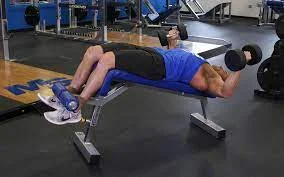
- Set the bench’s angle to 15 degrees.
- For stability, place your feet beneath the hook.
- Bend your elbows slightly as you extend your arms horizontally.
- To begin, push with your chest.
- Squeeze your elbows together with your arms.
- To maintain the tension in your pecs, extend your arms above your chest.
- As you drop your arms, flex your elbows.
- Repeat ten to twelve times.
Why Lower Chest Muscles Are Important?
If you want to build a powerful chest with well-rounded pecs, focus on your lower chest.
Most guys solely concentrate on developing their upper and mid chest muscles, ignoring their lower chest muscles. The issue is that this regimen won’t result in the pecs of your dreams!
There are two reasons why lower chest muscles are important:
Aesthetics: You can achieve the bodybuilder aesthetics you desire by adding weight to your total chest through a muscular and sculpted lower chest.
Function: Your daily actions that involve lifting, pushing, and moving depend heavily on your lower chest muscles.
5 Benefits of Training Your Lower Chest
The following are some major advantages of lower chest exercise:
- Improved breathing.
- Enhanced range of motion in the shoulders and arms.
- Strength building that aids you in pushing, carrying, and lifting.
- giving you a toned, chiseled appearance overall.
- A solid posture that not only communicates confidence but also reduces back aches in the longer run.
Tricks & Strategies To Keep In Mind While Performing Lower Body Exercises
Activate Your Pecs with The Right Angle
- When training your lower chest, make sure you select the angle that targets your lower pecs.
- To fully activate the range of motion in the targeted muscle, this is essential.
To determine the proper angle, choose:
- Start with light weightlifting.
- Reduce motions using the bench at an angle of 15° to 30°.
- Keep your back arched while pressing your shoulders and hips against the bench or seat.
- When exercising, keep your elbows tucked in and your upper arms and chest at a 45° angle.
Warmup With Secondary Muscles First
- The truth is, when you perform exercises for your lower pecs, your secondary muscles, such as your shoulders and triceps, also get active.
- They will most likely break first during your lifts.
- You won’t be able to express yourself to the fullest as a result.
- Warm up your auxiliary muscles first to avoid using them too soon.
This can be accomplished using:
- Rope pushdowns for triceps
- Overhead triceps
- Side lateral raises using dumbbells or cables
- Front lifts
Conclusion
Developing your lower pecs requires a lot of hard labor. It requires a great deal of training, discipline, and consistency. However, without them, you won’t have a superhero-level chest augmentation.
If you want to build muscle in your chest, you have to work out your upper, mid, and lower chest independently. Thus, be careful to give every muscle group the proper amount of training.
FAQ
Lower chest exercises are beneficial for a number of reasons. First, they help strengthen the muscles in the chest and correct posture. This might make regular chores like carrying groceries or lifting weights easier. It can also reduce the risk of injury from other exercises or sports.
Crossover of Cable (From Upper Pulley)Due to the plane of motion that they go through, cable crossovers are a great tool for targeting the lower pectoral region.
A more hard exercise for the lower chest is the chest dip. Although you’ll still need to use parallel or dip bars, this workout differs in that you won’t be working your triceps as much as in previous exercises. You must angle your movement in order to attack the lower chest.
There’s a prevalent misperception that the flat bench press works the lower chest significantly. The exercise targets the upper and middle chest, shoulders, triceps, and lower chest in addition to the latter.
The usage of machines is beneficial since, in my opinion, they allow you to target angles that are not possible with free weights.
References:
- Nasm, B. W. (2023, February 28). 5 Exercises That Can Help Build a Big, Strong Lower Chest. Men’s Health. https://www.menshealth.com/fitness/a39464129/lower-chest-workouts/
- S. (2023, October 30). 8 Best Lower Chest Exercises for Defined Pecs – SQUATWOLF. SQUATWOLF. https://blog.squatwolf.com/lower-chest-workouts/
- Richter, D. (2023, May 23). The 10 Best Lower Chest Exercises to Build Your Pecs. StrengthLog. https://www.strengthlog.com/lower-chest-exercises/

